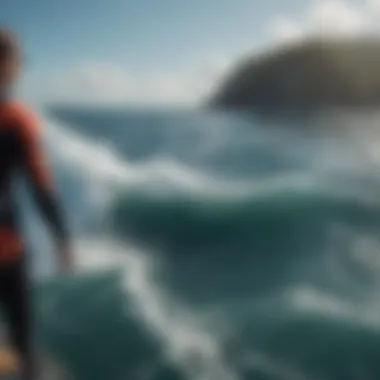Towards Plastic-Free Oceans: An In-Depth Exploration


Intro
The ocean, vast and mysterious, holds a critical role in our planet's ecosystem. Yet, it faces a severe threat from plastic pollution, which not only diminishes its beauty but also impacts wildlife and human health. The statistics are daunting; millions of tons of plastic enter the oceans every year, harming marine life and disrupting the delicate balance of ocean ecosystems.
In recent years, there has been a collective awakening, a surge of initiatives aimed at tackling this urgent challenge. This article seeks to explore these efforts, spotlighting innovative solutions, the part of community engagement, and the imperative of education in steering us away from a plastic-laden future. By weaving together various aspects, we will illuminate the path towards cleaner, healthier oceans, fostering a culture where sustainability is paramount.
Techniques and Skills
Essential Techniques for Beginners
To cultivate a plastic-free ocean environment, understanding certain techniques is vital even for those who are just dipping their toes into the waters of environmental conservation. Simple acts can have profound ripple effects:
- Reduce Single-Use Plastics: Swapping out plastic straws for bamboo or stainless steel ones is a good start.
- Mindful Shopping: Opt for products with minimal packaging or from brands committed to reducing plastic waste.
- Participate in Cleanup Activities: Getting involved in local beach cleanups not only aids in the immediate removal of plastic waste but also raises awareness within the community.
These newbie-friendly techniques pave the way for more sophisticated involvement in the conversation around ocean conservancy.
Advanced Skills for Experienced Watersport Enthusiasts
For those already knee-deep in watersports and environmental advocacy, the next level involves strategic approaches to further the cause.
- Sustainable Practices in Watersports: By adopting eco-friendly techniques, such as using biodegradable products, experienced enthusiasts can lead by example.
- Advocacy and Outreach: Engage with local government and organizations to push for policies that protect marine environments.
- Research and Innovation: Experienced individuals can contribute to or initiate research projects aimed at developing biodegradable alternatives to conventional plastic gear.
The advancement of individual and collective skills in these realms is essential for meaningful change.
"A drop in the ocean is insignificant, but every drop adds up to create a tide of change."
Equipment and Gear
Must-Have Gear for Each Watersport
When participating in watersports, the type of equipment you choose can significantly affect your environmental footprint. Some must-have gear to consider includes:
- Eco-Friendly Surfboards: Look for brands that utilize sustainable materials.
- Recycled Fishing Gear: Opt for nets and lines made from recycled plastics.
- Reusable Water Bottles: Keep hydrated while minimizing waste with stainless steel bottles.
Tips for Selecting the Right Equipment
Choosing the right equipment requires intentional thought as well.
- Prioritize Quality Over Quantity: High-quality items last longer and reduce the need for replacement.
- Research Sustainable Brands: Make informed choices by investigating companies committed to eco-friendly practices.
- Repurpose Existing Gear: Consider refurbishing or repurposing old equipment rather than discarding it.
These choices can contribute significantly to minimize our impact on the oceans.
As we embark on this expedition towards plastic-free oceans, each action—no matter how small—has a profound role in our collective success.
Understanding Plastic Pollution in Oceans
Plastic pollution in our oceans is not just a modern-day nuisance; it’s an intricate web of challenges that directly affect marine life, ecosystems, and, ultimately, humanity itself. Understanding this pollution is crucial for devising efficient strategies to mitigate its impact and create cleaner oceans. In this section, we will dive deep into the nature of plastic pollution, dissecting its definition and contextualizing it historically to illuminate how we got to where we are today.
Defining Plastic Pollution
Plastic pollution is characterized by the accumulation of plastic products and particles in the ocean, which can have detrimental effects on marine organisms and ecosystems. This matter isn't just about litter floating on the surface; it encompasses a vast range of materials, from discarded fishing nets to microplastics that are microscopic in size.
Key Points About Plastic Pollution:
- Types of Plastics: Common contributors include polyethylenes, polypropylene, and polystyrene, each with varying durations of decomposition, sometimes taking hundreds or thousands of years.
- Sources: A significant portion originates from land-based activities, including improper waste disposal and stormwater runoff, contributing to the pollution of oceans.
- Impact: The consequences of plastic pollution stretch beyond the ocean, affecting food chains and, subsequently, human health through seafood consumption.
Understanding the types and sources of this pollution lays the foundation for addressing the issue effectively. Recognizing what materials contribute to the problem and their implications is vital for fostering responsible behaviors and infrastructural changes.
Historical Context of Plastics in Marine Environments
The journey of plastic pollution begins decades ago when plastic marked the dawn of convenience in daily life. Post-World War II, plastics surged onto the scene as a ‘wonder material,’ ushering in an era of products that were cheap, durable, and light. However, few foresaw the long-term repercussions associated with widespread use.
At first, plastic consumption accelerated rapidly without much thought into disposal—be it packaging, utensils, or fishing gear.
“We’ve created a disposable culture that neglects the need for sustainability.”
By the late 20th century, scientists started documenting alarming discoveries: plastics were being found in the most remote ocean regions, even as early as the 1970s. Since then, awareness has grown, yet the lack of substantial measures to curb plastic production means that the problem has only exacerbated. Over 300 million tons of plastic are produced globally each year—a staggering figure when one considers that only a small fraction is recycled.
Reflections on the Historical Context:
- Cultural Shift: Our collective mindset towards convenience over sustainability laid the groundwork for the situation.
- Policy Gaps: Regulatory frameworks have ramped up, but they often lag behind the speed of plastic production.
- Rising Awareness: Documented effects on marine biodiversity are spurring calls for action among researchers, activists, and key stakeholders.
By understanding how plastic pollution evolved over the years, we can glean insights into potential pathways forward. It’s not simply about eliminating every piece of plastic but rather adapting our habits and policies to counteract the long-standing issues we face today.


Through this exploration, we recognize that plastic pollution isn't just an environmental topic; it's an urgent societal concern that calls for immediate attention and action, transcending borders and ideologies.
Sources of Oceanic Plastic Waste
Understanding the sources of plastic waste in our oceans is fundamental to tackling the problem effectively. Each piece of plastic that finds its way into marine environments originates from countless human activities and behaviors. Grasping these sources not only sheds light on the scale of the issue but also helps in identifying actionable strategies for remediation. Key considerations here include the means of disposal and the potential opportunities to curtail these contributions before they reach the waterways.
Land-Based Contributions
The major chunk of oceanic plastic pollution comes from land-based sources, which indicates a demand for better waste management systems and public awareness. Everyday items like plastic bags, water bottles, and food packaging are commonly discarded and can easily end up in rivers and eventually oceans, especially in areas lacking proper waste disposal facilities.
- Urban Runoff: Heavy rains can wash litter into storm drains, which often lead straight to the nearest waterway without any filtration. In urban settings, this runoff can carry not just plastics but also other pollutants.
- Improper Disposal: Many individuals feel it’s okay to litter or don’t take the time to recycle. Items like snack wrappers and single-use straws can blow away or be washed into the drain.
- Illicit Dumping: Surprisingly, some companies and individuals take shortcuts and dump waste directly into landfills or the ocean. This illegal action not only harms marine life but also risks contaminating coastal areas.
- Tourism: Popular tourist spots often suffer from increased littering, as visitors might not be as diligent about waste disposal as locals. In places like beach resorts, these activities can quickly clutter shorelines.
Addressing land-based contributions requires a multifaceted approach. Local governments can tighten regulations and improve public infrastructure, while educational campaigns can engage communities to take ownership of their environment. For instance, community-led initiatives to clean up beaches can foster a sense of responsibility.
Marine-Based Contributions
While land-based sources are prominent, we cannot overlook the marine-based contributions to plastic waste. These stem largely from activities directly related to the ocean, especially fishing and shipping industries. Understanding these can help create cleaner seas through better practices and regulations.
- Fishing Gear: Abandoned, lost, or discarded fishing gear, often termed "ghost gear," poses a significant threat to marine life. These nets can trap fish, turtles, and other creatures, leading to slow deaths.
- Shipping and Cargo: The maritime transport of goods introduces the risk of plastic pollution through the loss of cargo or accidental spills. Container ships sometimes lose containers overboard, releasing their contents into the ocean.
- Cruise Ships: Massive vessels ferrying thousands of tourists might not adhere to strict waste disposal regulations. Although efforts are being made to regulate waste management onboard, violations do happen.
Given the complex nature of marine-based contributions, industry stakeholders must prioritize cleaner practices and adopt sustainable technologies. Collaboration among businesses, regulatory bodies, and environmental organizations can pave the way for stringent measures and innovative solutions that target these particular sources.
To truly mitigate ocean plastic pollution, understanding both land-based and marine-based contributions is crucial. If stakeholders collaborate effectively, cleaner oceans could soon become our reality.
In sum, tackling plastic pollution is not just about cleaning up what's left; it’s about changing the systems and practices that lead to waste generation in the first place. Both land-based and marine-based contributions need to be addressed earnestly if we hope to turn the tide against plastic pollution.
Impact of Plastic on Marine Life
The ramifications of plastic pollution on marine life is a critical theme. Understanding how plastics impact ecosystems and wildlife is the stepping stone towards meaningful interventions. The presence of plastics disrupts the delicate balance of our oceans, affecting various species and their habitats. From large marine mammals to microscopic organisms, the consequences of plastic are far-reaching. This section seeks to unravel the specifics of how plastic interacts with marine life, revealing the urgency of remedial actions.
Wildlife Alterations
Plastic pollution manifests in various forms like microplastics and larger debris, which can alter wildlife behavior and survival rates. For instance, seabirds often mistake plastic for food. A study revealed that the albatrosses, known for their immense wingspan, frequently ingest plastic particles, leading to malnutrition or death.
- Albatross Feeding Behavior: Engulfing debris thinking it's prey
- Turtles and Plastic Bags: Sea turtles often confuse plastic bags with jellyfish and consume them, which leads to intestinal blockages.
These behavioral alterations can lead to a decline in certain populations, threatening biodiversity. Additionally, marine mammals, such as whales, can suffer from entanglement with fishing gear made of plastic, which can injure or even kill them. As these species struggle, the entire ecosystem begins to feel the strain.
Ecosystem Imbalance
The presence of plastics disrupts food webs and the intricate balance that governs ocean ecosystems. When plastic debris breaks down into smaller particles, it doesn’t just disappear; instead, it can change how nutrients cycle in the water. Microplastics can serve as a platform for harmful chemicals and bacteria, magnifying their impact when ingested by marine organisms.
“When plastic breaks down, it doesn’t just reduce in size, it often increases in toxicity.”
This cumulative effect can reverberate throughout the food chain. Predators feeding on smaller organisms that have ingested these microplastics might find their health compromised, which ultimately affects whole populations. Changes in certain species' populations can lead to an imbalance, resulting in overpopulation of some species and the decline of others.
Bioaccumulation of Toxins
As plastic waste breaks down in marine environments, it releases toxins like bisphenol A and phthalates, which can accumulate in the tissue of marine organisms. These toxins enter the food chain—a phenomenon called bioaccumulation. For example, when small fish consume microplastics, the harmful substances potentially fuse with their biological systems.
- Food Chain Impact: Larger fish eat smaller fish, increasing toxin concentration in top predators like sharks and tuna.
- Human Health Risk: As these fish make their way to our tables, humans are unwittingly pulling these toxins into their diets, raising potential health concerns.
The increasing concentration of these dangerous compounds in marine life calls for extensive research into how they affect not just individual species, but ecosystem health itself. Recognizing these risks could pave the way for more nuanced conservation policies aimed at protecting marine biodiversity.
In summary, the impacts of plastic pollution on marine life extend beyond the visible consequences. They are woven into the very fabric of ocean ecosystems, affecting not only wildlife but human health as well. Addressing this issue demands a comprehensive understanding and a united effort from communities, policymakers, and individuals alike.
Health Implications for Humans
The discussion around plastic pollution often centers on environmental consequences, but the health implications for humans are equally critical. As plastics continue to infiltrate our oceans, they don't just harm marine life but also pose serious risks to human health. This section aims to illuminate the pathways through which marine plastic pollution can affect us and underscores the intertwined fate of ocean health and human well-being.
Consumption of Contaminated Seafood
The ocean acts as a vast repository, not just of beautiful marine life but also of pollutants, including plastics. When we consume seafood, we often inadvertently take in microplastics along with it. Fish and shellfish can ingest these tiny particles, mistaking them for food. A study by the World Economic Forum indicates that, on average, a single human may consume around 11,000 pieces of microplastic annually, primarily through seafood. This situation raises alarms when we consider that some microplastics can absorb and carry toxic chemicals, such as pesticides or heavy metals.
Pathway of Contamination:
- Fishing Practices: Fishers often catch species that reside in areas with significant plastic presence, leading to a direct link between our plates and polluted waters.
- Food Chain Effects: As these microplastics move through the food chain, larger predatory fish also ingest contaminated prey, magnifying the risk for human consumers.
- Bioaccumulation: Filtering feeders like mussels and clams can accumulate substantial amounts of plastics, leading to higher concentrations in just a few species. This exacerbates health risks for those who consume them frequently.
Through eating seafood, individuals might unknowingly add microplastics to their diet, in stark contrast to their health objectives. Increasing awareness on this topic can empower consumers to make more informed choices about the seafood they eat, promoting not only personal health but also sustainable fishing practices.
Toxicological Risks
The presence of plastics in our oceans translates into a headache of toxicological risk for humans. It's not just the sheer presence of plastic that’s concerning; it’s the myriad of chemicals that cling to these fragments. Plastics are often manufactured using a cocktail of harmful substances. When plastics break down, they release these toxins into the marine environment, which can then find their way into human bodies through seafood consumption or even water.
Key Toxicological Concerns:


- Endocrine Disruption: Plastics can leach substances like bisphenol A (BPA), which disrupt the endocrine system, leading to hormonal imbalances.
- Carcinogenic Effects: Chemicals associated with plastics, including certain phthalates, have been linked to increased cancer risks.
- Immune System Impact: Studies have suggested that exposure to microplastics may lead to inflammation and disruptions in immune responses, increasing susceptibility to various diseases.
"The health consequences tied to microplastic ingestion are only beginning to be fully understood, and as research evolves, so too must our response to environmental stewardship."
The toxicity of ingested contaminants cannot be understated. Recognizing these risks is crucial for promoting proactive measures in personal choices and advocating for robust environmental policies.
Global Efforts to Combat Plastic Pollution
The growing concern over plastic waste in the oceans is not merely a local issue; it transcends borders and demands a concerted global effort. Recognizing the multifaceted nature of this crisis is essential. Without a unified vision, efforts to combat plastic pollution can become fragmented and ineffective. The importance of international collaboration, as well as robust national policies, cannot be overstated.
Joining forces allows countries to share strategies, resources, and expertise. Treaties and agreements work as frameworks, guiding nations in their fight against plastics entering the marine ecosystem. While each country might face unique challenges, the common goal remains the same—protecting our oceans. Let's unravel some of the key elements:
- Shared Responsibility: Plastic pollution doesn't recognize borders. Waste generated in one part of the world can drift thousands of miles, affecting marine life globally.
- Resource Optimization: Countries can leverage shared technologies and data to enhance waste management systems, reducing the financial burden on individual nations.
- Impact Measurement: Collaborative efforts allow the accumulation of data that can reveal trends and inform future actions, ensuring more effective responses to pollution.
"The ocean is a living organism. When we poison it with plastic, we hinder its ability to give us life."
International Treaties and Agreements
International treaties serve as the backbone of coordinated plastic pollution mitigation. Treaties like the Montreal Protocol, while primarily focused on ozone-depleting substances, set a precedent for global cooperation. It shows how joint action can lead to substantial environmental recovery.
A notable and emerging treaty is the proposal for a global plastics treaty under the auspices of the United Nations Environment Programme (UNEP). This proposed framework seeks to address the entire lifecycle of plastics—from production to disposal. Some key aspects include:
- Reduction Targets: Enforceable commitments to reduce plastic production and consumption.
- Monitoring and Reporting: Countries will need to track and report their plastic waste management efforts, fostering transparency and accountability.
- Financial Assistance: Support for developing nations to help with the transition to sustainable practices.
These agreements highlight the necessity of building a robust international mechanism to prioritize plastic-free oceans.
National Policies and Their Effectiveness
On the home front, national policies play a crucial role in combating plastic pollution. Countries have initiated diverse strategies that reflect their unique circumstances, but the effectiveness of these policies varies widely. Here are some typical approaches:
- Plastic Bans: Many countries have implemented bans on single-use plastics. For example, Kenya has enforced one of the strictest bans in the world; violators can face hefty fines.
- Deposit Return Schemes: Germany has pioneered deposit systems for plastic bottles, encouraging recycling and ensuring bottles return to the production cycle.
- Public Awareness Campaigns: Nations like New Zealand have launched extensive campaigns to educate their citizens about the impact of plastic waste.
Despite these efforts, challenges remain. Implementation can be lax, and enforcement is often inconsistent. Evidently, the effectiveness of national policies hinges not solely on legislation but on the commitment of all stakeholders—governments, businesses, and the public alike. Innovation combined with education can ensure the success of these policies, fostering a global culture of sustainability that protects our waterways for future generations.
Innovative Solutions for a Plastic-Free Future
As the grim reality of plastic pollution looms over our oceans, it’s crucial that we turn our attention to innovative solutions that can pave the way for a cleaner, more sustainable future. This section digs into the transformative measures that various sectors are exploring to combat the plastic crisis. The conversation doesn’t just dwell on the problems, but shifts focus towards practical steps forward, ensuring that every voice has a role in this endeavor.
Biodegradable Alternatives
Biodegradable alternatives are a significant step forward in the fight against oceanic plastic waste. Unlike traditional plastics that can linger for centuries, these materials are designed to break down into harmless substances over a relatively short period. Each has its own method of degradation, ensuring that they do not leave a lasting toxic footprint in marine environments.
From bioplastics made from cornstarch to materials derived from seaweed, the variety of options available is something to write home about. Companies are investing time and money into research, trying to come up with more effective biodegradable options that mimic the characteristics of conventional plastics while being more environmentally friendly.
More critically, the adaptation and implementation of these alternatives depend on awareness and consumer demand. As awareness grows, so does the potential for biodegradable products to replace their plastic counterparts in everyday life. It’s a big win-win: companies get to be part of a solution, while consumers can feel good about their choices.
Advancements in Waste Management Technology
The evolution of waste management technologies presents another layer of hope in tackling plastic pollution. Modern waste management systems are leveraging technology to enhance efficiency, aiming to capture and sort waste more effectively. With the rise of AI and machine learning, sorting facilities are improving their capacity to identify and separate plastics from general waste at remarkable speeds.
Additionally, innovations like waste-to-energy plants convert non-recyclable plastic into usable energy, reducing landfill use while harnessing alternative energy solutions. A closer look into ocean cleanup technology reveals that items like the Ocean Cleanup project are using advanced barriers and drones, fitting technology to collect floating debris before it sinks.
Key Advantages of Enhanced Waste Management Technology:
- Efficiency: Significantly reduces waste processing time.
- Resource Recovery: Converts waste into energy or raw materials for new products.
- Preventative Measures: Helps alleviate future marine pollution by capturing plastics promptly.
Ultimately, improved waste management isn’t just about cleaning up. It’s also about preventing pollution at its source, redirecting materials away from oceans and back into productive use.
Recycling Innovations
Recycling has always been a vital cog in the machinery of plastic waste management. In recent years, however, recycling innovations have taken center stage. Techniques such as chemical recycling are changing the way we think about plastics. Instead of being downcycled into lower-quality products, chemical recycling breaks plastics down to their original monomers, allowing for the creation of high-quality raw materials.
Moreover, expanding recycling facilities with better technology allows us to recycle a wider variety of plastics that were previously deemed unrecyclable. This adaptability is crucial. When you realize that there’s a way to salvage even more materials from the waste stream, the enthusiasm grows, accompanied by innovative social enterprises that encourage local communities to engage in recycling efforts.
"Recycling isn’t the end; it’s just the beginning of a new life for materials, fostering a circular economy that benefits everyone."
Engaging consumers in the recycling journey, offering incentives, and creating campaigns are part of making recycling a lifestyle, not just a responsibility. All in all, these innovations in recycling perfectly align with a vision of a plastic-free future, where materials are kept in use and out of our oceans.
Each of these innovative solutions uncovers a glimmer of hope in the daunting battle against plastic pollution. A willingness to adapt and innovate can help redirect our path towards a healthier ocean and ultimately, a healthier planet.
The Role of Community Engagement
Community engagement plays an essential part in addressing the plastic pollution crisis affecting our oceans. Every individual, from the casual beachgoer to the dedicated local activist, has a role to play in promoting sustainability. When communities come together, energy and ideas can amplify efforts to combat plastic waste, making significant strides toward a cleaner environment. This engagement brings a multitude of benefits, including fostering connections among residents, raising awareness about the urgency of marine conservation, and empowering people to take tangible actions.
Engaging with communities highlights collective responsibility. When people see their neighbors actively participating in clean-up initiatives or educational campaigns, it encourages others to join in. This grassroots involvement can lead to lasting changes in behavior, where individuals begin to rethink their daily decisions regarding plastic consumption and disposal. Moreover, community-level actions often influence local policies, pressuring authorities to implement stricter regulations on plastic use and waste management.


"The strength of the community can turn the tide against pollution, one small action at a time."
A thriving, well-informed community is better equipped to protect marine environments. The following sections will delve into specific avenues for community engagement, focusing on local clean-up initiatives and the importance of educational programs.
Technological Integration in Marine Conservation
As we navigate the turbulent waters of plastic pollution, the fusion of technology with marine conservation stands as a beacon of hope. This integration is critical because it allows us to understand, monitor, and combat the plastic crisis from multiple angles. The power of technology in this context is multifaceted, offering new tools and methodologies that provide insights not easily captured through traditional means. A high-tech approach brings about efficiency and precision, which are essential in tackling the massive scale of oceanic plastic waste.
Data Monitoring and Analytics
Data monitoring underpins effective marine conservation efforts. Technologies like satellite imagery and automated sensor networks enable real-time tracking of plastic waste distribution and movement. These tools help scientists and conservationists not only to map the extent of pollution but also to identify hotspots and patterns in waste accumulation.
For example, analyzing large datasets can reveal correlations between plastic waste sources and ocean currents, aiding preventative measures. The application of analytics in this context serves two purposes:
- Informed Decision-Making: By aggregating and analyzing data, stakeholders can better allocate resources and strategize cleanup efforts.
- Public Awareness and Policy Change: Transparent data can inform the public and policymakers, fostering a shared sense of urgency and responsibility towards ocean health.
Remote Sensing and Drones
Remote sensing technologies, including drones, have transformed plastic pollution monitoring. Drones, equipped with both cameras and sensors for detecting pollutants, can routinely survey marine environments and gather data from inaccessible areas. This is particularly vital for tracking changes over time, such as how quickly microplastics disperse or accumulate in specific regions.
The advantages of deploying drones include:
- Real-Time Surveillance: Drones can provide immediate feedback, allowing for faster response to pollution events or debris accumulation.
- Cost-Effectiveness: Compared to traditional survey methods or manned flights, drones offer a more affordable option for gathering critical environmental data.
"With remote sensing and drones, the ocean isn’t just a vast blue void anymore; it’s a landscape we can map and understand better than ever."
Although promising, it’s important to consider some limitations of these technologies. For example, data collected can sometimes be misinterpreted or might overlook localized pollution events. As such, these technologies should complement traditional methodologies rather than replace them.
In summary, the integration of technology in marine conservation is not just beneficial—it’s essential. Harnessing advancements in data monitoring, analytics, and remote sensing enables us to tackle the challenges of plastic pollution head-on. By embracing these innovations, we take a significant step toward realizing a future where marine ecosystems can thrive free from plastic waste.
Personal Responsibility and Sustainable Practices
In our modern world, the burden of plastic pollution doesn’t solely rest on governments or large corporations. Instead, personal responsibility plays a pivotal role in fostering sustainable practices that can mitigate the emerging plastic crisis. Individuals make choices daily that contribute to overall waste; thus, they hold significant power to influence change. Promoting conscientious consumer behaviors can ripple out to communities, leading to more substantial collective actions.
Reducing Individual Plastic Use
One of the simplest yet impactful practices individuals can adopt is the reduction of their plastic footprint. On a daily basis, folks often reach for convenience, opting for plastic bags or single-use containers. However, small changes can pave the way toward sustainability:
- Refuse plastic straws and cutlery: Bring your own reusable items when dining out or attending events.
- Choose bulk buying: Opting for bulk goods in containers reduces packaging waste significantly.
- Select natural fibers: When shopping for clothes, consider materials that don’t shed microplastics.
Each action might seem minor, yet when multiplied by millions, the cumulative effect of reducing plastic use can be nothing short of transformative. Changes in personal habits can daisy-chain into larger trends, creating a cultural shift toward sustainable practices.
Supporting Eco-Friendly Products
The rise of eco-friendly products provides individuals with viable alternatives to traditional plastic items. Embracing and supporting these options sends a clear message to manufacturers about consumer preferences. Some key advantages of opting for environmentally conscious products include:
- Sustainable sourcing: Many eco-friendly brands use biodegradable materials or responsibly sourced ingredients.
- Reduced chemical exposure: Many alternatives to plastic avoid harmful chemicals often present in standard plastic production.
- Supporting ethical practices: Eco-friendly companies often emphasize ethical labor and production methods.
When purchasing, look out for certifications or labels that indicate an item’s ecological impact. Supporting these products not only lessens personal plastic consumption, but also propels the market toward a greener future.
"The journey to a plastic-free ocean begins with each individual taking responsibility for their actions. Our choices collectively shape the tides of change."
In summary, personal responsibility, in conjunction with sustainable practices, is paramount in tackling plastic pollution's tidal wave. Reducing individual plastic use and supporting eco-friendly products may seem like climbing a mountain one pebble at a time, but each pebble is essential on the path to protecting our oceans and the life within them.
Future Outlook on Plastic-Free Oceans
The topic of achieving plastic-free oceans is a pressing issue in today’s world. Positioning this as a future outlook paints a picture where sustainable practices become integral to not just policy, but everyday life. As the challenges surrounding plastic waste intensify, understanding the trajectory of policy developments and setting long-term environmental goals become crucial components. These elements not only address immediate actions but also strategize for a future where our oceans can thrive once again without the burden of plastic debris.
A robust future framework for managing oceanic plastic pollution embodies several specific elements.
- Awareness and Education: Building a culture around awareness will play a pivotal role. Educating future generations about the adverse effects of plastic pollution ensures that ecological considerations become part of daily decisions.
- Innovative Policies and Practices: Enforcing stricter regulations on plastic production and usage can shift the tide. For instance, encouraging businesses to produce alternative materials could lead to innovative product designs that minimize plastic dependency.
- Community Involvement: Harnessing local communities to take initiative promotes grassroots awareness and solutions. From clean-up initiatives to educational outreach, community action is a powerful tool that reinforces collective responsibility.
"The vision for our ocean should reflect the change we want to see; it’s rooted in collaboration, innovation, and unwavering commitment."
Overall, a mindful approach to policy and practice can promote a series of systemic changes that directly combat plastic pollution.
Predictions for Policy Developments
The policies of tomorrow will shape our interactions with the ocean today. As we peer into the future, we can anticipate several shifts:
- Increased Legislative Measures: Governments around the globe are likely to introduce more comprehensive laws regarding plastics, potentially including bans on single-use plastics, placed at the forefront of new marine protection acts.
- International Collaboration: Given the transitory nature of ocean currents which carry waste across borders, a collaborative effort among nations will become essential. Treaties and agreements like the Paris Agreement could evolve to specifically tackle marine pollution.
- Corporate Accountability: Expect a shift where corporations take more responsibility for their packaging. Plastic producers could face regulations that mandate them to invest in recycling or alternative materials.
The importance of such developments cannot be overstated, as they not only impact immediate reduction efforts but also influence public perception surrounding plastic usage.
Long-Term Environmental Goals
Setting long-term goals is akin to drawing a roadmap for the future of our oceans. The vision is not just about eliminating existing plastic, but creating frameworks that cultivate sustainable ecosystems.
- Restoration of Marine Biodiversity: One goal includes working toward the rebirth of marine habitats, ensuring that life beneath the waves repopulates. Recovering ecosystems will require a combination of pollution control and conservation initiatives, alongside community engagement.
- Circular Economy Implementation: Transitioning into a circular economy could serve as the backbone of future initiatives. This would entail not only reducing plastic usage but also enhancing recycling efforts, ensuring materials are reused rather than ending up in the ocean.
- Monitoring Environmental Health: As we look ahead, incorporating data analytics to track environmental changes could become pivotal. Understanding the effectiveness of current policies through ongoing monitoring creates a feedback loop that informs future strategies.
The future outlook on plastic-free oceans is about envisioning a cohesive strategy that is inclusive and sustainable. By anticipating new policies and setting ambitious environmental goals, we can move toward a world where our oceans flourish, unburdened by plastic.







